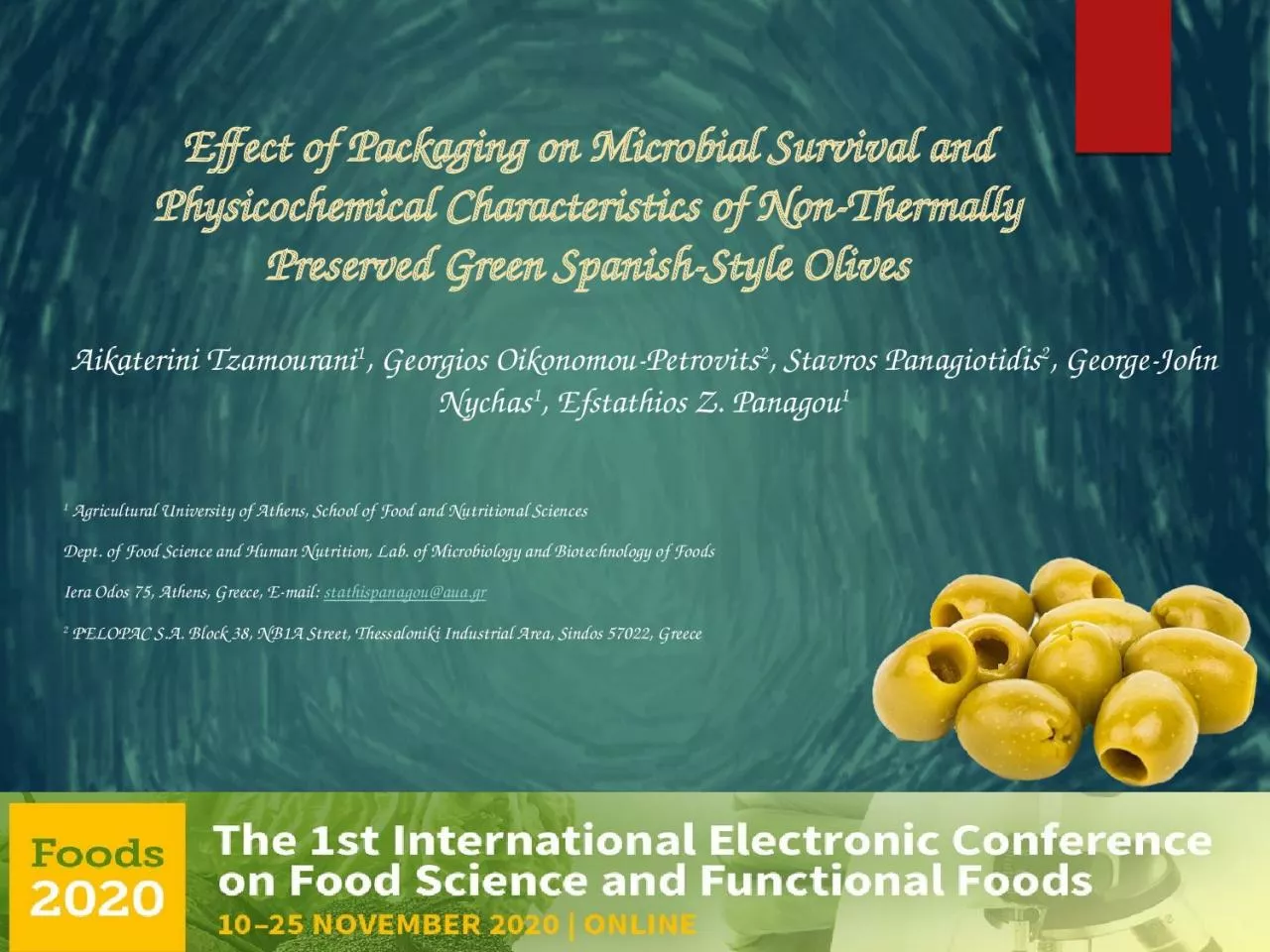

Aikaterini T zamourani 1 G eorgios OikonomouPetrovits 2 Stavros Panagiotidis 2 GeorgeJohn Nychas 1 Efstathios Ζ Panagou 1 1 Agricultural University of Athens School ID: 1010231
Download Presentation The PPT/PDF document "Effect of Packaging on Microbial Surviva..." is the property of its rightful owner. Permission is granted to download and print the materials on this web site for personal, non-commercial use only, and to display it on your personal computer provided you do not modify the materials and that you retain all copyright notices contained in the materials. By downloading content from our website, you accept the terms of this agreement.
1. Effect of Packaging on Microbial Survival and Physicochemical Characteristics of Non-Thermally Preserved Green Spanish-Style OlivesAikaterini Tzamourani1, Georgios Oikonomou-Petrovits2, Stavros Panagiotidis2, George-John Nychas1, Efstathios Ζ. Panagou11 Agricultural University of Athens, School of Food and Nutritional SciencesDept. of Food Science and Human Nutrition, Lab. of Microbiology and Biotechnology of FoodsIera Odos 75, Athens, Greece, E-mail: stathispanagou@aua.gr 2 PELOPAC S.A. Block 38, NB1A Street, Thessaloniki Industrial Area, Sindos 57022, Greece
2. Trade Preparations(Trade Standards Applying to Table Olives, COI/OT/NC no. 1, December 2004)Treated olives in brine (Spanish-style)Natural olives in brine (Greek-style)Olives darkened by oxidation (Californian style)Dehydrated and/or shriveled olives
3. Spanish-style green table olive processing
4. Greek varieties for Spanish-style processing cv. Conservoleacv. Halkidikihttps://olivetreeroute.gr/wp-content/uploads/Studies_Publications_017a.pdf
5. Packaging of table olives Glass containersPlastic containersCansMulti-laminated pouchesReduced size and weight Flexible Low permeability in O2 and water
6. Aim of this study Investigate the effect of modified atmosphere packaging of Spanish-style green olives (cvs. Halkidiki and Conservolea) in multi-laminated pouches on:microbiological, physicochemical and sensory characteristics
7. Materials and methods Samples of cvs. Halkidiki and Conservolea pitted green olives processed by the Spanish-method were packaged in high barrier multi-laminated pouches under modified atmospheres (30% CO2 / 70% N2) and stored at room temperature for 12 months. Microbiological analysis (TVC, LAB, yeasts, Enterobacteriaceae)Physicochemical analyses (pH, titratable acidity, salinity, color, texture)Sensory evaluation (IOC. COI/OT/MO No.1/Rev.2 (International Olive Council), 2020
8. Microbiological results Figure 1. Changes in the population of total viable counts (TVC), lactic acid bacteria (LAB) and yeasts on olive drupes of cvs. Halkidiki (a) and Conservolea (b) during modified atmosphere packaging in multi-laminated pouches. Data represent average values of duplicate samples ± standard deviation. (a)(b)
9. Microbiological results Enterobacteriaceae could not be enumerated during storage in all samples. LAB were the dominant microbiota and ranged between 5.4-6.4 log CFU/g and 4.5-6.2 log CFU/g for cvs. Halkidiki and Conservolea, respectively. Yeasts were detected within the first 60 days (maximum counts of 4.9 log CFU/g and 5.4 log CFU/g in cvs. Halkidiki and Conservolea, respectively)No yeasts could be detected on olives after 90 days of storage in both varieties.
10. Physicochemical results Figure 2. Changes in pH, salt content and titratable acidity during storage of packaged pitted green olives of cvs. Halkidiki (a) and Conservolea (b). Data represent average values of duplicate samples ± standard deviation(a)(b)
11. Physicochemical results Color parameters L*, a* and b* did not change during storage in both varieties. No statistically significant differences could be established for L* parameter.The values of a* and b* parameters indicated the prevalence of green and yellow tonalities among samples regardless of table olive variety.The force needed to penetrate the olive drupe was considered as a measure of the olive’s hardness and varied according to table olive variety and storage time. The mean value of hardness was 15-20 N and after 360 days of storage it decreased to 8 N.
12. The taste panel evaluated negative attributes (e.g., abnormal fermentation), gustatory attributes (salty, bitter and acid taste) and kinesthetic sensations (hardness, fibrousness, crunchiness). No perception of abnormal fermentation (zapateria, putrid, butyric) was noticed throughout storage. Sensory evaluation
13. Sensory evaluationcv. Halkidiki’s olives were bitter, acid, crisper and with increased fibrousness compared to cv. Conservolea. The majority of the sensory characteristics did not vary throughout storage in both varieties. After 10 months of storage all olive samples received approximately the same score with no important differences. The composition of the modified atmosphere is important since it affects the color and texture of olives. Overall, all samples were characterized as “Extra”.
14. ConclusionModified atmosphere packaging of Spanish-style green pitted olives in multi-laminated pouches revealed stability with minor changes in the microbiological and physicochemical characteristics of cvs. Halkidiki and Conservolea olives during 12-month storage. LAB dominated the olive surface from the beginning of storage whereas no yeasts could be detected after 3 months of storage. The absence of Enterobacteriaceae and the changes in the physicochemical parameters (within the acceptable limits) throughout packaging ensures the microbiological safety and stability of the product during storage.
15. On-going workInvestigate and characterize the dominant microbial species using molecular techniquesImprove packaging conditions by testing different MAP composition and packaging materials
16. Thank you for your kind attention